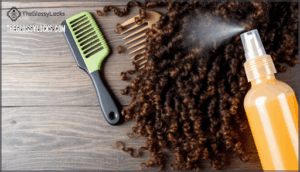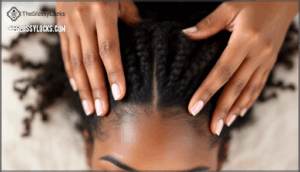This site is supported by our readers. We may earn a commission, at no cost to you, if you purchase through links.

When 96% of Black women experience high breakage rates and your hair shrinks by 75%, that half-inch vanishes before you ever see it. The real challenge isn’t making your hair grow. It’s keeping what you’ve already grown.
Understanding the difference between growth and retention changes everything about how you care for your coils.
Table Of Contents
- Key Takeaways
- Identifying and Understanding 4C Hair
- Moisturizing Techniques for 4C Hair
- Gentle Detangling and Breakage Prevention
- Protective Styling to Promote Growth
- Scalp Care and Growth Stimulation
- Nutrition and Lifestyle for Healthy 4C Hair
- Frequently Asked Questions (FAQs)
- What is the best way to style 4C hair?
- Are there any products specifically formulated for 4C hair?
- How often should I trim my 4C hair?
- Are there any natural remedies for growing 4C hair?
- How do I prevent breakage when styling 4C hair?
- How often should I trim 4C hair?
- Can I air dry 4C hair safely?
- What nighttime routine protects 4C hair best?
- Should I use protein treatments on 4C?
- How long does 4C hair take to grow?
- Conclusion
Key Takeaways
- Your 4C hair grows at the same rate as all hair types (about half an inch monthly), but extreme shrinkage up to 75% and breakage rates affecting 96% of Black women make growth invisible—the real challenge is retaining length, not stimulating growth.
- Moisture retention is critical because your tight coil pattern blocks natural oil distribution down the hair shaft, so you need intentional hydration strategies like the LOC method (liquid, oil, cream) applied every 48-72 hours to reduce water loss by 30%.
- Protective styling and gentle detangling are your most effective breakage prevention tools—wet detangling with conditioner reduces breakage by 15-25%, while protective styles like twists and braids cut friction by 50-60% and boost moisture retention by 30-40%.
- Scalp health directly impacts growth potential, so combine regular scalp massages (5-10 minutes daily to boost blood flow) with strategic cleansing every 1-2 weeks using sulfate-free products, plus targeted treatments like rosemary oil that match minoxidil’s effectiveness after six months.
Identifying and Understanding 4C Hair
Before you can grow your 4C hair to its full potential, you need to understand what makes it unique. This hair type has specific characteristics that influence how it grows and reacts to care.
Let’s break down what defines 4C hair, the challenges you’ll face, and the myths you can ignore.
Key Characteristics of 4C Hair
Your 4C hair is distinct in its tightly coiled strands that form a zig-zag or "Z" pattern—not obvious ringlets. With curl diameters under 3mm, these densely packed coils create impressive volume and shrinkage rates of 70-75%, making your hair appear much shorter than it really is.
This hair texture shows varying porosity levels and increased fragility due to its kinked structure, requiring mindful handling to prevent breakage and preserve those beautiful, tightly wound hair strands. Understanding how it looks when both wet and dry is key for proper care.
Common Growth Challenges for 4C Hair
Despite your hair’s steady growth of about 0.5 inches monthly, you face three major hurdles that disguise progress:
- High breakage rates – 96% of African-American women report hair breakage, with mechanical stress from grooming causing internal cracks and unpredictable fractures along the shaft
- Extreme shrinkage – up to 75% length concealment makes growth invisible, showing only 25% of true length
- Moisture retention challenges – tightly coiled structure blocks scalp oil distribution, causing rapid water evaporation and persistent dryness
These factors combine to create the illusion of slow growth when you’re actually battling breakage prevention and length retention issues. Many women also avoid exercise because of hair styling problems.
Myths About 4C Hair Growth
These misconceptions hold many women back from reaching their hair’s potential. Nearly half of study participants wrongly believe 4C hair grows slower than straight hair, when growth rate actually sits at 0.5 inches monthly across all textures.
Product claims fuel confusion too—84.4% think castor oil guarantees growth despite weak scientific backing.
Heat damage gets oversimplified: while 92.6% correctly flag frequent straightening as harmful, controlled heat with proper protection won’t destroy your strands.
Washing frequency myths persist, though twice-weekly cleansing promotes scalp health. Understanding these common myths about 4C hair helps you focus on what truly works for growing 4C hair.
Moisturizing Techniques for 4C Hair
If there’s one thing 4C hair craves more than anything, it’s moisture. Your tight curl pattern makes it tough for natural oils to travel down the hair shaft, so you’ll need to be intentional about keeping every strand hydrated.
Here’s how to build a moisture routine that actually works.
Choosing Effective Moisturizers and Sealants
Your moisturizer choice hinges on porosity. Low-porosity 4C hair needs lightweight, water-based formulas with humectants like glycerin—dense creams block absorption by 40%.
High-porosity strands lose moisture fast, so seal with heavier butters containing emollients and occlusives. Jojoba or avocado oil reduces water evaporation by 30%.
Apply moisturizing creams every 1–2 days for best hair moisture retention without hygral fatigue.
How to Layer Products for Maximum Moisture
With the right approach to product consistency, your 4C hair can hold moisture for up to 72 hours. The LOC method—liquid, oil, cream—cuts water loss by 30% when you match products to your porosity alignment.
- Start with damp strands: Apply water-based leave-in conditioners first for 35% better absorption
- Seal with plant oils: Argan or castor oil traps moisture up to 60% longer than synthetics
- Lock with creams: Moisturizing creams create a barrier that holds hydration for 48 hours
- Time it right: Layer every 48–72 hours to avoid buildup and maintain hair moisture balance
Deep Conditioning and Co-Washing Tips
Weekly deep conditioning treatments are non-negotiable for 4C hair health—they cut structural damage by 35% when paired with low-sulfate cleansing. Apply heat during treatment to boost absorption by 50%, then rinse cool to seal cuticles.
Co-washing 1–2 times weekly preserves 80% more natural oils than traditional shampoos. For product selection, choose protein-based conditioners with humectants like glycerin, but balance them with moisturizing formulas to avoid stiffness.
Common mistakes include overheating and skipping clarifying washes every 15 days.
Gentle Detangling and Breakage Prevention
Detangling 4C hair doesn’t have to mean breakage if you use the right approach. Your technique, tools, and timing can make all the difference between healthy retention and unnecessary damage.
Here’s what you need to know to keep your strands intact while working through tangles.
Detangling Tools and Methods for 4C Hair
Your detangling approach matters more than you might think—wide-tooth combs reduce tension by 45% compared to fine-tooth versions, greatly cutting mechanical breakage.
Here’s how to choose your tools for gentle detangling and hair breakage prevention:
- Comb Comparison: Wide-tooth combs minimize detangling 4C hair stress, while paddle brushes can increase root breakage by 20% without proper conditioning.
- Brush Types: Flexible detangling brushes with flexi-bristles reduce strand breakage by 25–35%, improving glide efficiency by 30% on coily textures.
- Finger Detangling: Though slower, this method causes 50% fewer broken strands per session compared to aggressive brushing—your hands provide the gentlest touch.
- Sectioning Benefits: Dividing hair into 4–8 parts cuts detangling time by 30% and prevents re-tangling during the process.
Always start at your ends and work upward—this technique alone decreases 4C hair breakage by 60%. Product application with conditioner increases slip by 40–50%, making every stroke smoother and safer.
Wet Vs. Dry Detangling Best Practices
Your hair’s wetness changes everything—wet strands lose 40% of their strength, but gain the slip you need for gentle detangling. For 4C hair, wet detangling benefits win: conditioner slip reduces breakage by 15–25% compared to dry methods that spike friction by 60%.
Here’s your comparison:
| Factor | Wet Detangling | Dry Detangling |
|---|---|---|
| Breakage Rate | 15–25% lower with slip agents | 35% higher in coily textures |
| Best For | 4C hair, tight coils, matting prevention | Looser patterns, quick touch-ups |
| Friction Level | 40% lower with conditioner | 60% higher static charge |
| Technique | Section into 4–8 parts, apply conditioner | Use light oils, finger-separate first |
| Frequency | 1–2 times weekly max | As needed, avoid over-manipulation |
Wet detangling with sectioning strategies and proper tool selection protects your strands—it’s hair breakage prevention that actually works.
Reducing Tangles and Matting
Think of your coils as velcro strips—the tighter they wind, the more they catch on each other. Protective styles like twists or braids cut frictional contact by 50–60%, while silk or satin pillowcases slash nighttime tangling by 45%.
Hydration strategies matter: the LOC method keeps strands detangled for up to 72 hours by sealing moisture layers that prevent dryness-driven matting. Trim every 8–12 weeks to stop split ends from traveling upward—those account for 15–20% of tangling cases.
Avoid product buildup with sulfate-free cleansers to maintain smooth cuticles and reduce inter-strand friction.
Protective Styling to Promote Growth
Protective styling isn’t just about looking good—it’s one of the most effective ways to shield your 4C hair from the daily friction and manipulation that lead to breakage. When done right, these styles can help you retain length while keeping your strands healthy and hydrated.
Let’s look at how protective styling works, which styles deliver the best results, and how to keep your hair moisturized while it’s tucked away.
Benefits of Protective Styles for 4C Hair
Protective styles function like a shield for 4C hair, addressing several growth-limiting factors simultaneously. They boost moisture retention by 30–40% compared to loose styling, reducing environmental exposure that strips hydration from your strands.
You’ll also see breakage reduction of up to 50% since manipulation drops by 80%. Scalp health improves as UV damage and irritation decrease.
Time efficiency skyrockets—cutting your daily routine by 70% and supporting consistent hair length retention and growth.
Best Protective Styles for Length Retention
Box braids and two-strand twists lead the pack for 4C hair length retention, cutting breakage by 40% when tension stays moderate. Cornrows and knotless braids work well for 4–8 weeks, but watch your edges—too-tight styles cause traction alopecia in 33% of users.
Mini twists preserve 90% of elasticity with weekly moisture, while updos reduce split ends by 35%.
Rotate between styles and take 1–2 week rest periods; skipping breaks increases breakage by 25–30% from accumulated stress.
Maintaining Moisture in Protective Styles
Once you lock in a style, maintaining 4C hair moisture retention becomes your next priority. Spray a water-based leave-in conditioner every 2–3 days to keep your scalp hydration above 70% and prevent that 50% moisture loss 4C hair naturally faces.
Sealing methods matter—layer oil after moisturizing 4C hair to trap hydration 28% longer. Environmental influence plays a role too; humidity swings over 40% accelerate dryness.
Ideal frequency? Twice-weekly applications maintain elasticity and extend style duration by 10–12 days. Protective styling products with humectants boost internal hydration by 17% within 24 hours.
Scalp Care and Growth Stimulation
Your scalp is where growth begins, so treating it right matters as much as caring for your strands.
A healthy scalp creates the foundation for stronger, longer 4C hair.
Here’s what you need to know about massage techniques, cleansing routines, and targeted treatments that encourage growth.
Scalp Massage Techniques and Oils
Why does massage frequency matter so much for maintaining a healthy scalp? Consistent stimulation boosts follicle activity and blood flow, making it essential for 4C hair growth. Here’s your routine:
- Massage 5–10 minutes daily using circular fingertip motions on the crown, temples, and nape—no nails, just gentle pressure techniques.
- Combine peppermint oil (1–3%) with a carrier 2–3 times weekly for menthol-driven vasodilation and cooling antimicrobial effects.
- Try rosemary oil blends—studies show it matches minoxidil’s efficacy after 6 months with less scalp itching.
- Add castor oil for moisture retention, not growth—its ricinoleic acid soothes irritation and promotes scalp health beautifully.
- Use massage tools for uniform coverage or warm compresses to improve vasodilation and assure consistent tool efficacy across sessions.
DIY recipes work: mix oils, stay patient for 6+ months.
Cleansing Routines for a Healthy Scalp
Your scalp needs consistent cleansing to support healthy 4C hair growth. Shampoo every 1–2 weeks with sulfate-free formulas to balance oil removal and moisture retention—over-washing strips 30% more natural oils per session. Use lukewarm water (37°C) and a gentle scalp massage to boost circulation by 51% without causing irritation. Clarifying shampoos tackle product buildup monthly but can deplete 40% of lipids if overused. Between full washes, try co-washing to manage dryness. Post-cleanse care matters: deep conditioner restores elasticity by 25%, and scalp oils lock in 39% more moisture.
| Cleansing Step | Best Practice |
|---|---|
| Shampoo Frequency | Every 1–2 weeks (10–14 days) |
| Water Temperature | Lukewarm (37°C) to protect cuticles |
| Scalp Massage | Gentle fingertips, 51% circulation boost |
| Clarifying Wash | Once monthly for buildup removal |
| Post-Cleanse Care | Deep condition + scalp oil application |
Scalp Treatments to Encourage Growth
To boost scalp health and hair growth, clinical treatments work wonders. Microneedling benefits include a 42.6-hair count increase after seven sessions, while essential oil blends like rosemary-lavender boost growth rates by 57.73%. Bioactive serums raise density by 7.97% in just 30 days.
Herbal therapies improve follicle activity by 30%, and mechanical stimulation with scalp massagers increases blood flow by 20–25%. Rosemary mint scalp hair strengthening oil delivers rosmarinic acid for promoting hair growth through improved circulation.
Nutrition and Lifestyle for Healthy 4C Hair
Your hair’s health starts from the inside out, and what you eat matters more than you might think. The nutrients you consume, how much water you drink, and the damage you avoid all play a direct role in how well your 4C hair grows.
Let’s look at the key factors that support strong, healthy growth.
Essential Vitamins and Nutrients for Growth
Your hair follicles need specific nutrients to thrive, and deficiencies can stall growth or trigger excessive shedding. Vitamin D aids new follicle creation—deficiency affects up to 80% of those with certain hair loss conditions. Iron intake matters because low ferritin shows up in 60% of women experiencing thinning, while zinc benefits include DNA replication in follicle cells.
Here’s what promotes hair growth from within:
- Biotin sources like eggs and almonds strengthen keratin infrastructure, improving tensile strength after 90 days
- Vitamin C from bell peppers and guavas protects against oxidative damage while boosting collagen production by 18%
- Iron-rich foods such as lentils and spinach deliver oxygen to follicles, improving density within 12–16 weeks
- Zinc from oysters and pumpkin seeds cellular repair—30 mg daily restored hair density in clinical trials
- Vitamin D from fatty fish and fortified dairy stimulates keratinocyte differentiation for healthier follicle function
Nourishing hair from within by eating vitamin-rich food directly impacts hair health at the cellular level.
Hydration and Its Impact on Hair Health
Why does water matter so much for 4C hair? Your follicles depend on systemic hydration to maintain nutrient transport and cellular function—dehydration reduces scalp blood flow by measurable margins, slowing the anagen phase. Drinking 2–2.5 liters daily improves hair elasticity and softness within eight weeks.
Hard water exposure weakens tensile strength by 8–10%, but chelating shampoos reverse mineral buildup effectively. Pairing internal water intake with moisture retention techniques creates hydration synergy, reducing breakage up to 25% while supporting scalp hydration and overall hair health.
Limiting Heat and Chemical Damage
What if the real damage happens long before you notice thinning or breakage? Heat styling above 302°F accelerates protein loss by 40%, while chemical relaxers break down cortex bonds, reducing elasticity permanently.
Heat protectants buffer cuticle disruption during blow-drying—trim damaged ends every 8–10 weeks to stop splits from traveling. Chemical alternatives like flexi-rods minimize hair loss, and deep conditioning post-heat restores depleted moisture.
Avoiding damaging hair products preserves tensile strength, preventing hair breakage before it compounds into visible damage.
Frequently Asked Questions (FAQs)
What is the best way to style 4C hair?
For 4C hair styling, prioritize low manipulation and protective styling options. Twists, braids, buns, and bantu knots reduce breakage while locking in moisture.
Focus on gentle detangling methods and maintaining scalp health between styles for best results.
Are there any products specifically formulated for 4C hair?
Yes, the market now offers numerous 4C-specific brands and product lines designed to address your hair’s unique needs.
These formulations emphasize intense moisture, gentle cleansing, and scalp health—exactly what your tight coils require to thrive and grow.
How often should I trim my 4C hair?
Most trichologists recommend trimming 4C hair every 3 to 4 months. Regular trims prevent split ends and hair breakage, supporting better length retention.
Watch for damage signs like visible split ends, excessive tangling, or rough ends between professional trims.
Are there any natural remedies for growing 4C hair?
Natural approaches like scalp oils—especially peppermint, rosemary, and castor oil—can stimulate 4C hair growth effectively. Plant-based ingredients, including aloe vera, hibiscus, and amla, strengthen follicles.
Dietary intake rich in omega-3s and protein promotes healthy hair from within.
How do I prevent breakage when styling 4C hair?
Breakage in 4C hair styling stems from mechanical stress on fragile strands. Detangle only when wet with conditioner—this reduces breakage by 98%.
Avoid tight styles that create tension, choose protective styling with gentle manipulation, and seal moisture nightly.
How often should I trim 4C hair?
You should trim 4C hair every 8 to 12 weeks—that’s roughly every 2 to 3 months.
This trimming frequency prevents split ends from traveling up the hair shaft, which aids length retention and reduces hair breakage.
Regular trims are your maintenance strategy for healthier hair growth.
Can I air dry 4C hair safely?
Yes, you can safely air-dry 4C hair—think of it as the tortoise winning the race.
Gentle drying with proper moisture retention, strategic detangling methods, and product penetration prevents hair breakage and hair dryness while supporting healthy hair maintenance.
What nighttime routine protects 4C hair best?
Your best defense against hair breakage starts with satin accessories like a silk bonnet and protective styles such as braids or twists.
Apply the LOC method for moisture retention, detangle gently with conditioner, and stay consistent—routine consistency increases length retention by up to 30%.
Should I use protein treatments on 4C?
Ironically, many think 4C hair’s inherent strength means it doesn’t need protein—but your tightly coiled strands actually benefit greatly from targeted protein treatments.
These hair care products rebuild internal bonds and reduce hair breakage when used correctly, though protein sensitivity varies.
Choose treatment types with smaller molecular weights for deeper penetration, watch product concentration (1-10%), and avoid over-proteinization by balancing with moisture.
How long does 4C hair take to grow?
Your 4C hair grows at roughly 5 inches monthly—about 6 inches yearly. But shrinkage up to 75% masks true length, making growth appear slower than it actually is.
Proper retention factors and realistic timelines matter most for visible results.
Conclusion
Think of your hair like a garden—you can water the seeds all you want, but if the fence is broken, nothing survives long enough to flourish. Learning how to grow 4c hair means accepting that growth happens naturally.
Your real work lies in protecting what’s already there. Master moisture, handle your strands gently, and give your scalp the attention it deserves. The length you’ve been chasing isn’t hiding—it’s just waiting for you to stop breaking it off.
- https://mylivara.com/how-often-should-4c-hair-be-moisturized/
- https://www.carolsdaughter.com/blog/hair/hair-care-tips/4c-hair-care-tips.html
- https://naturallclub.com/blogs/the-naturall-club-blog/7-tips-to-maintain-grow-and-care-for-4c-hair
- https://www.yelani.com/blogs/lets-talk-hair-care/black-hair-s-secret-superpower-how-4c-hair-follicles-may-heal-skin-faster-science-backed
- https://www.fabulive.com/blogs/news/the-best-protective-hairstyles-for-curly-hair-3b-to-4c










